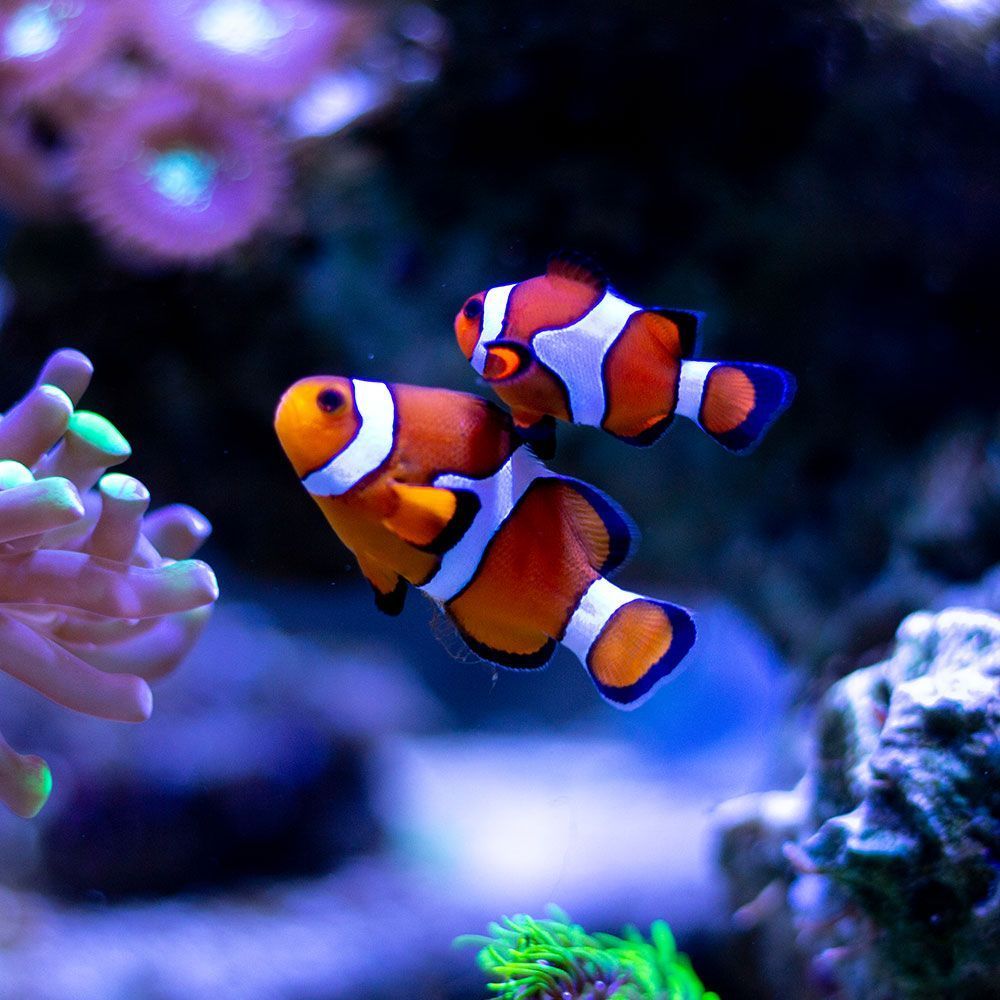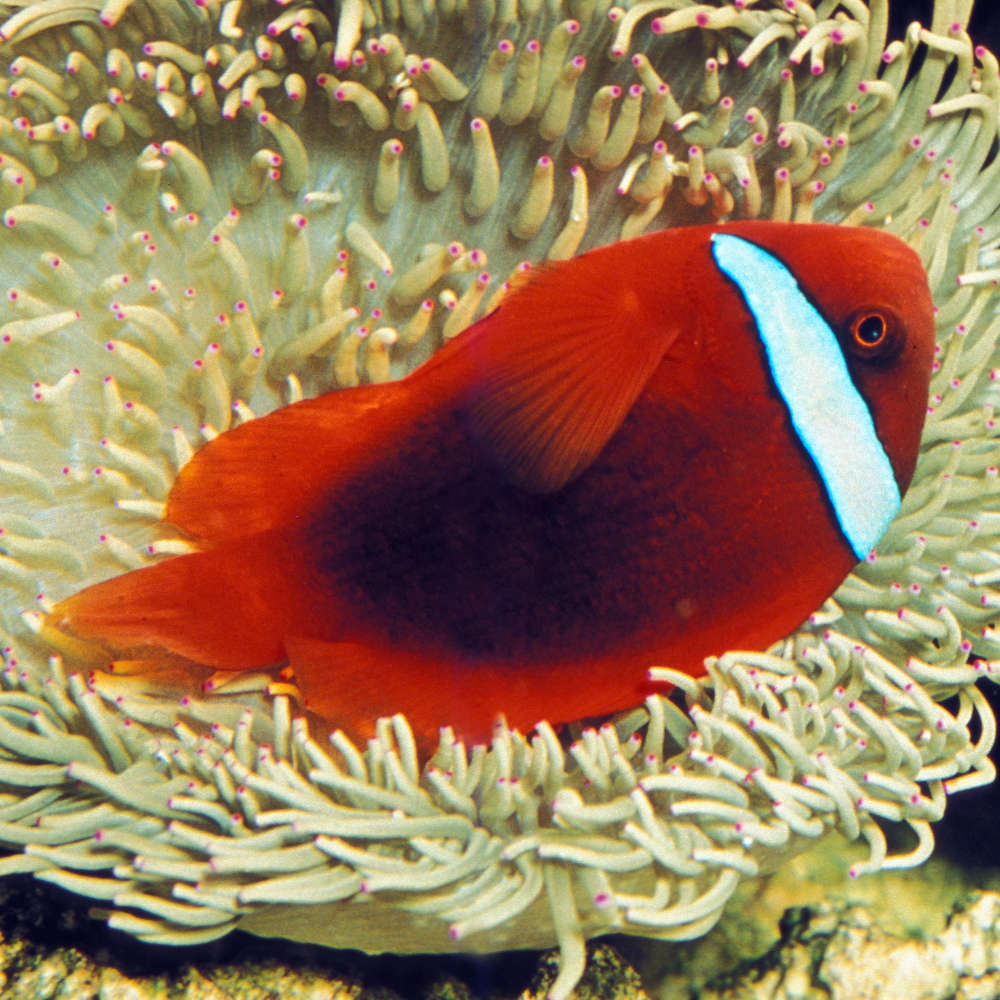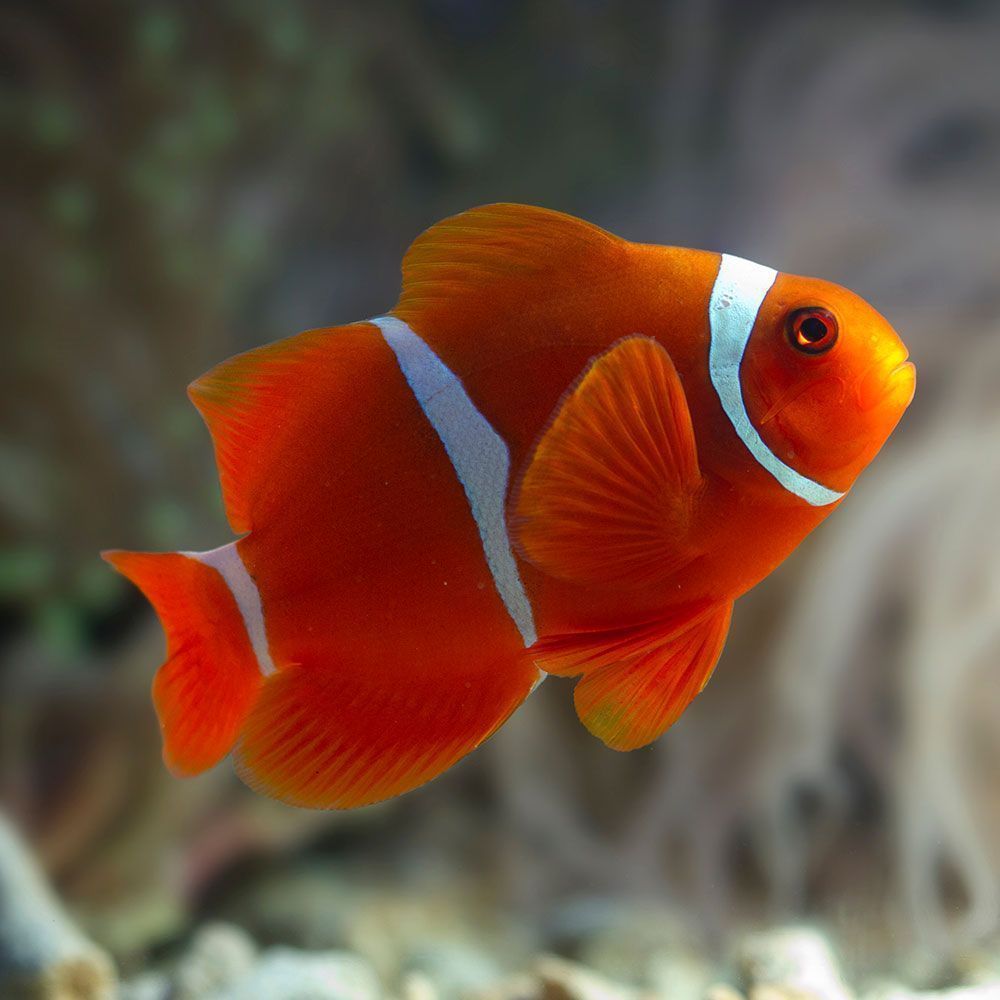Clownfish species are the ideal addition to your saltwater aquatic realm if you are looking for an easy-to-care and colorful fish with bold personalities.
Whether you’re a beginner who wants to step up in fishkeeping or a knowledgeable and expert aquarist, there’s a fascinating clownfish for everyone!
These fun buddies survive happily, even in smaller tanks, and readily eat most kinds of food.
If you are intrigued to know more about these fun species, keep reading!
What is a Clownfish?
Clownfish, also known as anemonefish, belong to the subfamily Amphiprioninae in the family Pomacentridae.
There are thirty recognized species, primarily in the genera Amphiprion and Premnas. They live in the warmer waters of the Indian and Pacific Oceans. They mostly stay at the bottom of shallow seas in shallow lagoons or sheltered reefs.
Clownfish have a thick mucus coating (3-4 times thicker in adult clownfish compared to other species). It masks their scent and prevents triggering the anemones’ stinging cells. Thus, they can thrive among venomous sea anemones.
They also establish symbiotic relationships with sea anemones where clownfish feed on anemone leftovers. On the other hand, clownfish waste nourishes the sea anemone.
Clownfish are also protandrous hermaphrodites, i.e., they are always born males, and the dominant male undergoes a transformation into a female.
These diurnal fish are also known to be pretty territorial and aggressive. Clownfish also don’t glide like typical fish but waddle, resembling a cheerful dog approaching for a greeting. Their vibrant hues and comical waddling earned them their name.
Note
After being featured in the Disney film Finding Nemo, it led to the increased demand for clownfish as pets. This led to overfishing and endangering their populations. Therefore, it is better to go for a captive-bred clownfish rather than wild-caught ones.
Even if you get one, verify if it was caught using safe methods. Don’t support pet shops selling clownfish caught using cyanide that damages the fish and their coral reef habitats.
Here are the most popular clownfish that can make a striking addition to your tank!
1. Common Clownfish (Amphiprion ocellaris)

- Other Common Names: False percula clownfish, anemone demoiselle, anemone fish, western clown fish, puller, nemo, false clownfish, false clown anemonefish, damselfish
- Average Size: Up to 11 cm (4.3 in)
- Average Lifespan: Usually up to 6-12 years, Max: 27 years
- Tank Level: All levels
- Temperament: Semi-aggressive, especially towards other clownfish species
- Diet: Omnivorous
- Reef Safe: Yes
- Tank Mates: Own mate, most other peaceful non-clownfish saltwater species, anemones
- Minimum Tank Size: 10 gallons for one
How does a Common Clownfish Look?
The flat, round-bodied common clownfish ranges in color from orange to reddish-brown and sometimes black, depending on its location.
Its body has three vertical white stripes outlined in black: one behind the eye, another in the middle, which slightly widens toward the head, and the third encircling the tail base.
All fins have black outlines. It has a rounded caudal fin.
What is the difference between a common clownfish and orange clownfish?
Common clownfish is often confused with orange clownfish, but they can be differentiated as follows:
- The common clownfish has a thin black band compared to the thick band in the orange clownfish.
- Common clownfish have slightly duller colors and plain heads, while orange clownfish have bulging faces.
- The common clownfish has a greyish-orange iris, making its eyes appear larger. The orange clownfish has a bright orange iris, making its eyes seem smaller.
2. Clark’s Anemonefish (Amphiprion clarkii)

- Other Common Names: Yellowtail clownfish, black clown, brown anemonefish, two-banded anemonefish, sea bee, sea anemone, Clarcki’s clown, chocolate clownfish
- Average Size: Males up to 10 cm (3.9 in); females up to 15 cm (5.9 in)
- Average Lifespan: Around 5-10 years
- Tank Level: All levels, bottom-dwelling if anemones present
- Temperament: Semi-aggressive
- Diet: Omnivorous
- Reef Safe: Yes
- Tank Mates: Own mate, large semi-aggressive species, top dwellers, anemones
- Minimum Tank Size: 30 gallons
How does a Clark’s Anemonefish look?
The black clownfish has a stocky, laterally compressed, and oval-to-rounded body.
Typically, it is black dorsally and orange-yellow ventrally, with black areas widening as it ages. There are two vertical white bands, one behind the eye and one above the anus.
It has a white caudal peduncle, orange or pinkish snout, orange-yellow dorsal and caudal fins, lighter or whitish caudal fin.
There are extensive color variations based on location, sex, age, and host anemone.
Adults in Vanuatu and New Caledonia are orange-yellow with two white bands. Females may have a white caudal fin, while males have a yellow one.
Juveniles are orange-yellow with white bands. When living with the Stichodactyla mertensii anemone, they are mostly black with white snout bars and tails.
The scientific and common name of this fish- Amphiprion clarkii and Clark’s anemonefish, pay tribute to the Scottish engraver John Heaviside Clark (1771–1836). He created illustrations for Bennett’s book, showcasing fascinating fishes found on the coast of Ceylon.
3. Maroon Clownfish (Premnas biaculeatus)

- Other Common Names: Spine-cheeked anemonefish, spinecheek clown, gold stripe clown, maroon anemone fish
- Average Size: Up to 17 cm (6.7 in)
- Average Lifespan: Around 3-5 years in captivity, 6-10 years in the wild
- Tank Level: All levels, bottom-dweller if there’s an anemone or coral
- Temperament: Territorial and aggressive, especially towards other clownfish and smaller fish
- Diet: Omnivorous
- Reef Safe: Yes
- Tank Mates: Large semi-aggressive fish, anemone, coral
- Minimum Tank Size: 30 gallons for one
How does a Maroon Clownfish look?
With an oval-shaped body, the maroon clownfish stands out with distinctive cheek spines and smaller scales.
The color ranges from orange to deep maroon or even purplish brown. It has 3 vertical white or yellow bands that can be thin or broad.
“Mis-barred” specimens are also available, i.e., the bars extend only across the top of their bodies and not the sides.
Males are brighter, and females’ bars turn white when provoked.
The fish also comes in expensive designer varieties, like:
- Gold-stripe maroon clownfish: It has wide yellow stripes, with females displaying deeper red hues.
- Lightning maroon clownfish: It has erratic lightning-like patterns that intensify as it matures.
The female maroon clownfish is the largest, followed by the breeding male. The male non-breeders are the smallest.
4. Tomato Clownfish (Amphiprion frenatus)

- Other Common Names: Tomato anemonefish, red tomato clown, red clown, one bar anemonefish, fire clown, bridled anemonefish, blackback anemonefish
- Average Size: Up to 14 cm (5.5 in)
- Average Lifespan: 6-8 years average, Max: 18 years
- Tank Level: All, more in the bottom if there’s hosting anemone/coral
- Temperament: Territorial and aggressive, especially towards other clownfish species and smaller fish
- Diet: Omnivorous
- Reef Safe: Yes
- Tank Mates: Large semi-aggressive fish like tangs and wrasses, anemones
- Minimum Tank Size: 30 gallons for one
How does a Tomato Clownfish look?
The tomato clownfish has a distinct reddish-orange body. It has a single large black-edged white bar just behind the eye joined over the head.
Female fish, larger in size, turn blackish (sometimes dark spots) on the sides with age. The male remains red.
Juveniles are darker red and have two or three white stripes but lose them as they grow older.
It’s often confused with
- Australian clownfish: Tomato clownfish can be differentiated with its distinct black outline around the white band from these.
- Cinnamon clownfish: It has a broader white headbar and black pelvic and anal fins.
5. Orange Clownfish (Amphiprion percula)

- Other Common Names: Percula clownfish, clown anemonefish, puller, orange anemonefish, eastern clown anemonefish, demoiselle, damselfish, black finned clownfish
- Average Size: Up to 8-11 cm (3.2-4.3 in)
- Average Lifespan: Mostly 8-10 years in captivity, Max: 20-30 years with the best care
- Tank Level: Top dwellers, all if there’s an adopted host anemone/coral
- Temperament: Territorial and semi-aggressive, especially towards conspecifics and other clownfish and smaller fish
- Diet: Omnivorous
- Reef Safe: Yes
- Tank Mates: Peaceful fish of similar size, anemones, corals, invertebrates
- Minimum Tank Size: 30 gallons for one
How does an orange clownfish look?
The orange clownfish has a deep orange body with three white lines: one behind the eye, one down the middle with a forward projecting bulge, and one near the base of the caudal fin.
These lines are outlined in thick black, which darkens as the fish ages. Each fish has unique white bars that vary in shape and size.
It has black eyes with an orange outline. There’s a noticeable dip in the middle of the dorsal fin, creating the illusion of double dorsal fins.
Available in different variants, some of them are:
- Misbar percula clownfish: In it, white bars are partially or totally missing.
- Snow onyx percula clownfish: It has wide middle bars.
- Platinum percula clownfish: It is milky white, without black bars, specks, or markings, and might have an orange nose.
- Picasso percula clownfish: It has unique disconnected white bars.
- Black percula clownfish: It flaunts more black than orange.
- Black crest percula clownfish: It features a black body with the dorsal fin between first and second white bars.
Female percula clownfish are like queens in their groups. They can be bossy and aggressive, while males are more appeasing and try to please everyone.
A word from FishInAquarium
Clownfish are fascinating and colorful aquatic pets with lively personalities and funny swimming styles.
Some of these fish can live up to 30 years, making them a long-term commitment. With a clean and suitable environment, these fish can be your besties for decades!
Though most of these fish are aggressive, they can thrive peacefully in well-researched community tanks.
If you found this information helpful and informative, consider sharing it with others who might benefit from it, too. Feel free to reach out via email if you have further questions or need any kind of support.
Happy fishkeeping!


